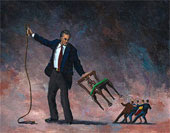 MarketWatch looked at Morningstar’s “best funds” recommendations in Stupid Investment of the Week. Here are some highlights:
MarketWatch looked at Morningstar’s “best funds” recommendations in Stupid Investment of the Week. Here are some highlights:
Morningstar Mutual Funds started listing the best funds for the year ahead six years ago. Typically, most funds that have made the list are “analyst picks” at the firm — meaning the favorites of Morningstar’s analytical crew — with established managers and investment styles.
The list itself seems to run contrary to Morningstar’s own institutional thinking. The firm has always been focused on the long haul, with virtually every analyst I have ever talked to far more concerned with what a fund will do over the next five years than the next 12 months.
From the start, the editors of the newsletter have hedged their bets a bit, suggesting the selections were for the next year “and beyond.” This year, Karen Anderson, taking her first shot at the list as editor of Morningstar Mutual Funds, makes no bones about the idea that “whether you’re constructing your portfolio for the first time or looking to make some upgrades, I’ve compiled a list of offerings that investors should consider for the long haul.”
But when you say you are producing a list of “the best funds” for the coming year, you create an expectation that the issues you pick will actually be good performers in the year ahead. There, Morningstar hasn’t done so well.
Over the first five years of this endeavor, 71 funds were named to the list (in about one-seventh of those picks, a fund actually made the list for a second or third year). Using year-to-date data for 2009, nearly two-thirds of the funds picked landed in the top half of their peer group during the year for which they were expected to be “best.”
…
“Morningstar has a lot of smart people who are trying their best, and who are smart statisticians,” said Mark Hulbert of the Hulbert Financial Digest, which ranks the performance of investment newsletters and is a service of MarketWatch, the publisher of this report.
“What they are revealing with these lists,” he added, “is just how difficult it is for any of us to identify top performers, to say ‘This is what’s going to be the next great investment.’ Even among funds with absolutely fabulous track records, picking next year’s winners is tough.”
…
If you consider that every Morningstar editor creating this annual list has suggested that the funds they picked would be good long-term performers, then the one calendar year that now has a five-year history — the picks for 2005 — should have all been long-term winners. That didn’t happen. While 20% of the picks from that year rank in the top 10% of their peer group, roughly half of the “best funds for 2005” fall below their category average over the last half decade.
It’s not just the performance that is the problem with this list. If you tried to use it to build a portfolio, there would be significant overlap. Each year’s list is published without reflection on the previous year, or any mention of what someone might do if they bought those other funds. Moving from one annual list to the next would generate tremendous turnover.
…
Instead, the “best funds for 2010” is more like a gimmick — fun to read and to chat about, but not in keeping with the long-term thinking that investors (and Morningstar analysts) typically use.
Said Dan Wiener, editor of the Independent Advisor for Vanguard Investors: “This is good marketing for Morningstar. What it’s not is good investing.”
Personally, I have never thought much of the Morningstar ranking scheme or their forecasting abilities. It’s nothing more than a bunch of statisticians making wild guesses and never admitting that there is a flaw in the entire approach.
Morningstar is the ultimate buy-and-hold supporter, and they have not learned or chose to ignore that bear markets exist along with the devastating effects that they have on a portfolio. To continue to release the “best funds for 20xx” without giving any consideration to the possibility of a market collapse (and what to do if it happens) is simply being ignorant and out touch with reality.
Sure, if their fund list appeals to you, you can certainly use it as a guide and incorporate their recommendations with the trend tracking rules. If the trends stay up in 2010, great, you may have some winners here; if we have a return into bear market territory, use my recommended trailing sell stop discipline to get back on the sidelines.
That way, you can incorporate the best of both worlds: Be ‘possibly’ in the “best funds,” yet have a safety net in place should the bears become the rulers of 2010.






